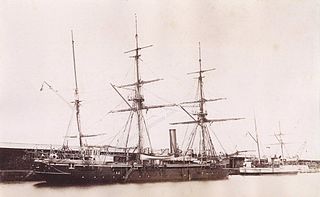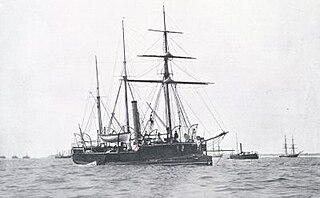
HMS Algerine was a Phoenix-class steel screw sloop of the Royal Navy. She was launched at Devonport in 1895, saw action in China during the Boxer Rebellion, and later served on the Pacific Station. She was stripped of her crew at Esquimalt in 1914, and transferred to the Royal Canadian Navy in 1917, being commissioned as HMCS Algerine. She was sold as a salvage vessel in 1919 and wrecked in 1923.

HMS Shearwater was a Condor-class sloop launched in 1900. She served on the Pacific Station and in 1915 was transferred to the Royal Canadian Navy as HMCS Shearwater, serving as a submarine depot ship until 1919. She was sold to the Western Shipping Company in May 1922 and renamed Vedas.

HMS Vixen was an armoured composite gunboat, the only ship of her class, and the third ship of the Royal Navy to bear the name. She was the first Royal Navy vessel to have twin propellers.

The Beagle class was a two-ship class of 8-gun screw steel sloops built for the Royal Navy in 1889.

The Phoenix class was a two-ship class of 6-gun screw steel sloops built for the Royal Navy in 1895. Both ships participated in the suppression of the Boxer Rebellion, but Phoenix was destroyed in a typhoon while alongside in Hong Kong in 1906. Algerine became a depot ship at Esquimalt, was sold in 1919, and was finally wrecked in 1923.

The Condor class was a six-ship class of 10-gun screw steel sloops built for the Royal Navy between 1898 and 1900. Condor foundered in a gale, prompting the Royal Navy to abandon sailing rigs for its ships; all the others in the class survived into the 1920s. The last of the class, Mutine, survived until 1932 as a Royal Naval Volunteer Reserve drill ship.

The Cadmus class was a six-ship class of 10-gun screw steel sloops built at Sheerness Dockyard for the Royal Navy between 1900 and 1903. This was the last class of the Victorian Navy's multitude of sloops, gunvessels and gunboats to be constructed, and they followed the traditional pattern for 'colonial' small warships, with a full rig of sails. After them, the "Fisher Reforms" of the Navy ended the construction and deployment of this type of vessel. All of the class survived until the 1920s, remaining on colonial stations during World War I.
HMS Viper was an armoured iron gunboat, the only ship of her class, and the fourteenth ship of the Royal Navy to bear the name.

HMS Wasp was a Banterer-class composite screw gunboat of the Royal Navy, built in 1880 by Barrow Iron Shipbuilding and wrecked off Tory Island in 1884.

HMS Mullett was a Royal Navy 5-gun Philomel-class wooden screw gunvessel launched in 1860. She served on the coast of West Africa and on the North America and West Indies Station before being sold in 1872 at Hong Kong for mercantile use. As the sailing ship Formosa she sailed in the Far East before being converted to a magazine in Melbourne.

HMS Raven was a Banterer-class gunboat of the Royal Navy, built by Samuda Brothers of Poplar, London, and launched on 18 May 1882. She served on the Australia Station and was converted to a diving tender in 1904. After being lent as a training ship in 1913 she was sold for breaking in 1925.

HMS Rambler was an Algerine-class gunvessel of the Royal Navy, built by John Elder & Co., Glasgow and launched on 26 January 1880. She was commissioned as a survey vessel in 1884 and served in Chinese waters during the 1880s and 1890s. She provided men to a naval brigade during the Boer War and was sold on 23 January 1907. The work of this vessel is now remembered in Hong Kong by the Rambler Channel near Tsing Yi.

The Algerine-class gunvessel was a class of three Royal Navy composite gunvessels built in 1880. Two of them were sold after only ten years of service, but the other was converted to a survey ship before commissioning and survived in this role until 1907.

HMS Jaseur was an Algerine-class gunboat launched in 1857. She served on the North America and West Indies station for less than two years before her loss by stranding on the Bajo Nuevo Bank in the Caribbean on 26 February 1859.

HMS Trent was a Medina-class gunboat launched in 1877. She was the fifth ship of the Royal Navy to be named after the River Trent. She was renamed HMS Pembroke in 1905, and served off the coast of Tanganyika in 1915. She was renamed HMS Gannet in 1917 while serving as a diving tender. She was scrapped in 1923.

HMS Phoenix was a Royal Navy Phoenix-class steel screw sloop. She was launched at Devonport in 1895, saw action in China during the Boxer Rebellion, and later served on the Pacific Station. She had the misfortune to be alongside a coaling pier in Hong Kong on 18 September 1906 when a typhoon struck the colony. She foundered and became a total loss.

The Medina-class gunboat was a class of 12 Royal Navy Rendel gunboats mounting three 6.3-inch guns, built between 1876 and 1877. Flat-iron gunboats were normally built without masts or rigging, but the Medinas carried a full barquentine rig. Their robust iron hulls meant that they lingered on as diving tenders, barges and lighters, with five of them working into the 1920s. The hull of Medway lies in shallow water in Bermuda and is visible on satellite imagery.
Six ships of the Royal Navy have borne the name HMS Jaseur, the name coming from the French for the waxwing.

The Albacore-class gunboat, also known as "Crimean gunboat", was a class of 98 gunboats built for the Royal Navy in 1855 and 1856 for use in the 1853-1856 Crimean War. The design of the class, by W. H. Walker, was approved on 18 April 1855. The first vessels were ordered the same day, and 48 were on order by July; a second batch, which included Surly, were ordered in early October.


















